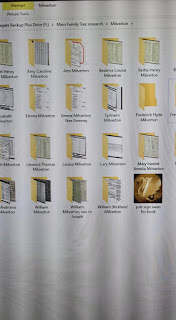Recently I had to build a whole new computer after my old
one decided to basically blow up on me. I turned it on and the computer went
‘pop’. I was hoping at that time I had not lost the records that I had been looking
at online and had saved to my PC. I soon realised that I had not backed up my
basic family tree records for a little while, along with my emails. Luckily I
had a back up computer with an external Hard Drive that I had been backing
things up onto over time.
While waiting for computer parts to arrive, I started looking through the
depths of the external drive and found I had files all over the place and
didn’t really know what I had. I had double ups and even triple ups of the same
record. I don’t even know if I have any that have gone missing over time. I
decided that I needed records under surnames and then individuals. That was I
can easily look for the person and know what I do have on them. I have sorted
people into their maiden and married names, although that probably adds to the
confusion, but at least I will know. I have gone through my files in the
program I use and been including the addresses people lived at during the
census periods. Something that I have not included before apart from their
occupation.
Due to the pandemic I have had access to my family history group’s details for
Find My Past and have been finding records for family who have lived in the UK
that I hadn’t found on Ancestry. The electoral rolls have turned up names and
addresses between 1920 and 1930 UK that I previously did not have. Some of
those records were on my old computer and I was able to salvage them and
several other records once the computer was working. Might be time consuming,
but also pictures I took of records too, I will include in the individual files
as I want to make sure I have enough on them. In a strange way it is basically
a dossier of individuals that do include news articles too.
Slowly I am moving my emails from the ISP email server to my Yahoo account as emails tend to vanish unless I download them into outlook. I have always tried to backup my work as I move along, but I had become lazy, but I do make sure I have a backup every now and then. I have recently started backing up once every couple of weeks. I should go through the physical records I do have and make sure I know that I have them instead of them going missing too, or just updating. I have had friends tell me I should backup to the cloud and even Dropbox. While I do have Dropbox, I would prefer to have them on a device, so that I can access them later especially without the internet.
Will I make the same mistake in the future? Most likely, but at least I will take care of the records I do have hiding on external drives, although I should point out those dont last forever either.

